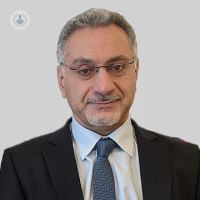The most successful pilonidal sinus surgical procedures
Escrito por:Pilonidal sinus (PS) is an inflammatory condition that affects the inter-gluteal region between the buttocks (natal cleft) over the sacrum (the base of the spine) and the coccyx (commonly referred to as the tailbone).

PS is sometimes wrongly described as a congenital cyst (‘congenital’ meaning ‘present before or after birth’). But actually, PS is an acquired condition which most commonly occurs between the ages of 16 to 25, and is 3-4 times more common in men. The exact incidence and prevalence of PS is not known and varies significantly between countries. In the UK, it’s estimated that 0.7 per cent of people experience PS.
Causes of pilonidal sinus
It is believed that PS starts from an injury to hair follicles in the deep natal cleft. The resulting folliculitis leads to swelling and a localised abscess which ruptures, but fails to heal, leaving small holes or ‘pits’.
The ingrowth of loose, shedding hair is a secondary phenomenon due to the hair follicles being driven into the pits by the shearing forces of the moving buttocks. This results in micro tunnels (also known as sinuses) developing under the skin, which are closed off at one end.
Symptoms
Many cases remain non-symptomatic and patients might not be aware of the condition’s existence, which makes estimating the frequency of PS in the population difficult.
Nearly half of patients with PS present acutely (as an emergency) and with a very painful large swelling over the natal cleft, which can turn into an abscess (a collection of pus).
The majority of PS cases appear chronically as one or more holes or pits in the midline (natal cleft). From the pits, there may be lateral (sideway) extensions, either as swellings (a sinus) or discharging openings on the skin (called a fistula) to one or both buttocks. These present with intermittent flare-ups causing swelling, pain, or discharge.
Treatment
Various non-surgical methods of treatment have no proven benefit. Therefore, treatment is usually surgical. People with non-symptomatic cases of PS can be observed and treated expectantly.
In emergency cases, abscesses require prompt incision and drainage, unless they are caught early as painful, red swelling (cellulitis) when antibiotics may cure the acute (sudden) infection.
Many operations are described to be the definitive treatment of PS and there is no consensus. However, there is now a growing recognition that the modern management of PS requires a procedure which:
- remove minimal tissue, especially the healthy local fat, thus avoiding large spaces and cavities (which can become infected).
- involve the primary closure of the skin in an off-centre, asymmetric manner, away from the midline.
The most successful procedures for pilonidal sinus
The best known and most successful procedures are the cleft lift and Karydakis flap procedures. These can be used in almost all simple and complex cases but do require specific training to perform the technique correctly.
Cleft Lift procedure (and other asymmetric flaps)
Fortunately, the vast majority of even complex recurrences of PS can be cured by the cleft lift procedure or an appropriate asymmetric flap. Both the cleft lift and Karydakis Flap are associated with mild post-operative pain (as opposed to the lay open or midline closures, which leave a large cavity or significant tension). Post-operative pain can be managed by simple painkillers.
Outdated procedures
Unfortunately, despite the growing evidence, a significant proportion of general or colorectal surgeons treating PS disease use a simple procedure such as ‘wide excision and laying open’ or ‘wide excision and midline suture’ which are increasingly becoming outdated. The former leaves a large open wound over the sacrum that can require weeks or months of daily dressings for the wound to heal, and the latter has a high incidence of fluid collection leading to wound infection and breakdown, again resulting in a large open wound.
Not surprisingly, there is a high frequency of recurrent PS disease or non-healing open wounds after surgery in the UK and worldwide. These cause significant problems for young and otherwise active, healthy individuals. This negatively affects their work, relationships and quality of life.
Surgery aftercare for Cleft Lift procedure
After surgery, patients can move normally but should follow certain guidelines.
- Avoid direct pressure on the operated flap by sitting leaning forwards or on one side.
- Walk normally after surgery.
- Shower and wash after the wounds are closed and covered with waterproof skin glue or a similar dressing.
- Avoid strenuous exercise for 12 to 14 days after surgery.
The recurrence of pilonidal sinus
The recurrence rate of PS is very low after a well performed cleft lift procedure, around three per cent or less. However, on occasion there can be a minor collection of fluid under the skin that can cause swelling and pain in around 10 per cent of people, but true wound infections after surgery are less common and happen in approximately five per cent of cases.
Mr Emin Carapeti is renowned for his experience in simple and complex pilonidal sinus surgery. Discover more about his treatment for colorectal conditions on his profile.


